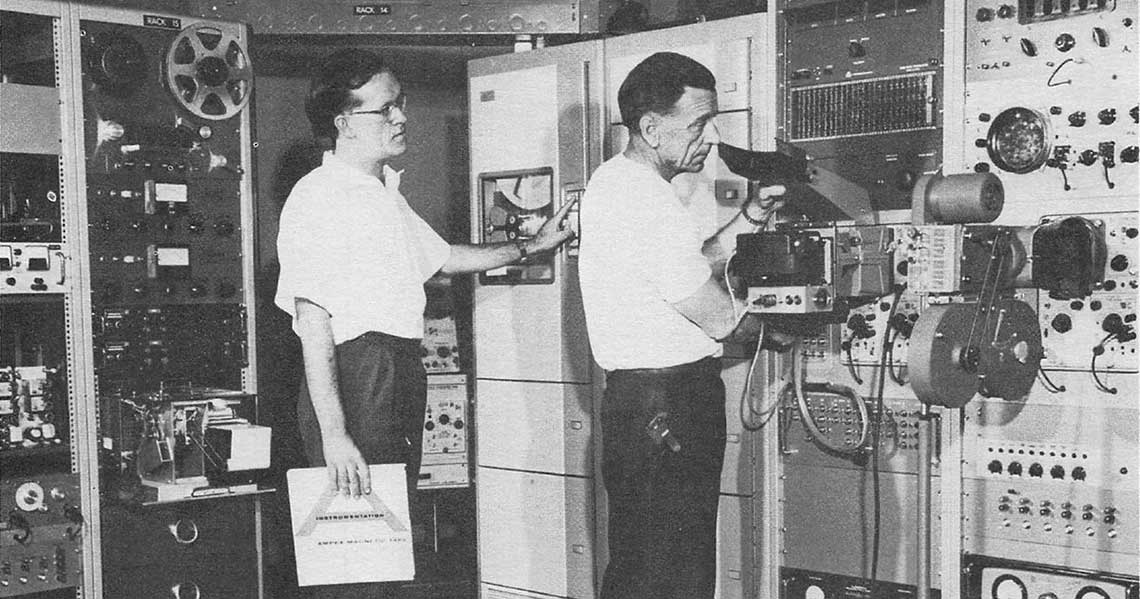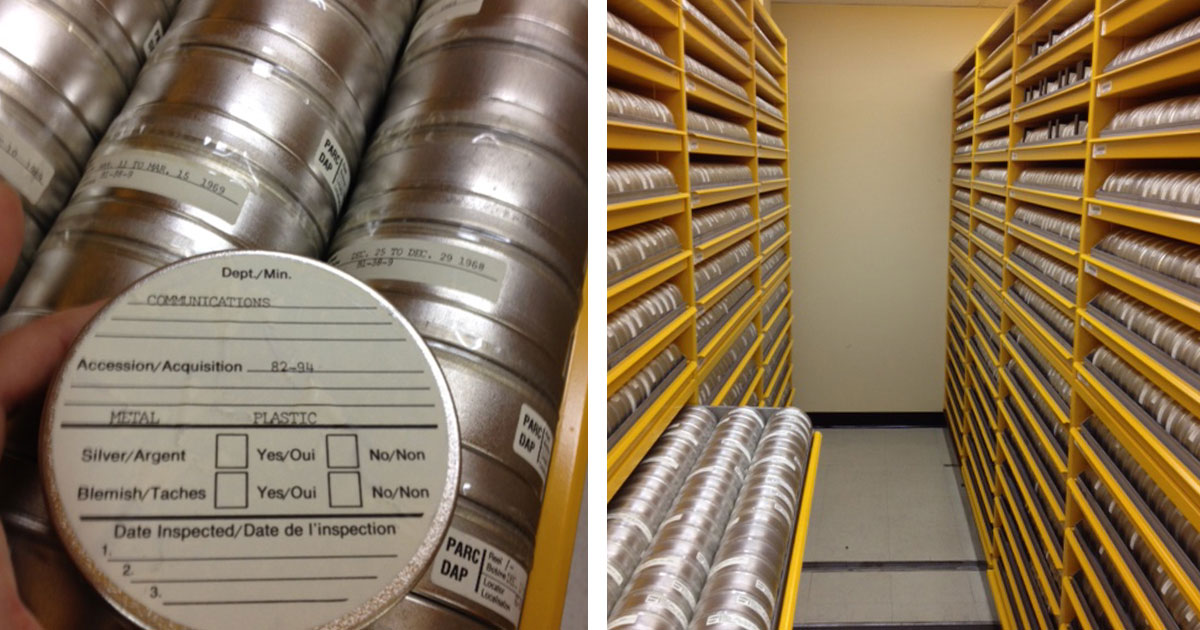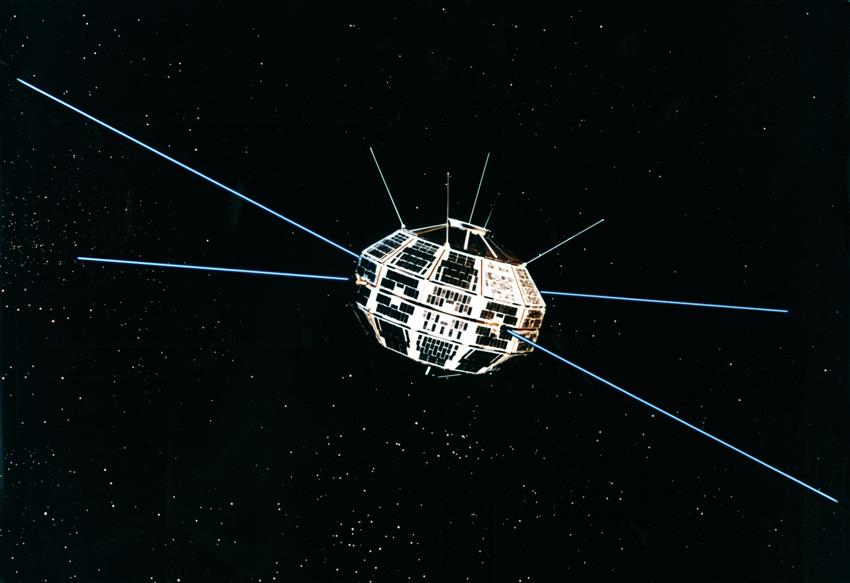Alouette-I: saving its data… 60 years later!

Canadian engineers at the Canada's Defence Research Telecommunications Establishment Ottawa reduction center check equipment used to process Alouette data. (Credit: NASA, "Alouette: Canada's First Satellite – NASA Facts," )
Some doubted that Canada's first satellite would even work. But at a time when satellites were designed and expected to last only a few months, Alouette-I transmitted data for over 10 years, outlasting any other satellite of its era! Launched on , Alouette-I was the first satellite to be completely designed and built by a country other than the USSR or the USA.
Launched on , the Alouette-I science satellite marked Canada's entry into the space age. (Credit: CSA, NASA)
Much has been written about the scientific and engineering legacy of Alouette-I over the years. Its scientific results contributed greatly to the development of long-distance communications, among other things, that we often take for granted today. Yet, decades later, the data was nearly lost, if not for the foresight and effort to save it.
Now, the data has been extracted, processed and digitized. It could be used with today's computational methods to produce a more comprehensive model of Earth's ionosphere in the 1960s, or for any other scientific or creative purposes not thought of yet.
Making ionograms
Alouette-I's data was processed at the Canada's Defence Research Telecommunications Establishment (DRTE). The data processing facility was located at the Shirleys Bay campus close to Ottawa. This is where technicians would listen to Alouette-I's signal and process tapes of data.
Their job was to produce ionograms, which depict the reflections of radio waves emitted from the satellite off the top side of the ionosphere. The ionograms were recorded on 35 mm film.

Ionogram recorded on 35 mm film. (Credit: CSA)
Thanks to a large network of international ground stations collecting the data, there were thousands of tapes coming in daily shipments, from Quito, Ecuador; Woomera, Australia; and Resolute Bay in the Canadian Arctic, to name just a few.
The DRTE data processing facility was the only place in the world that could produce high-quality ionograms. It operated 70 hours a week, and in its first six years processed and recorded about 2.3 million ionograms!
Animation of ionograms as they would have been seen on 35 mm film. (Credit: CSA)
Why was there so much data from Alouette-I?
The simple answer: the mission lasted a long time.
Among the design choices that led to the exceptional longevity of the satellite was a very high standard of quality control. Colin Franklin, Alouette-I's chief electrical engineer, and his team, realized that commercial semiconductor transistors did not have the quality needed for space applications. So, they worked with manufacturers to make transistors and circuits that could operate under great temperature and power supply variations.
The team also took the bold approach of making the transmitter power 10 times greater than the minimum required. According to Franklin, “This was a milestone decision that eased the antenna design and the mass production of high-quality ionograms.”
Listen to Colin Franklin on the design challenges of Canada's first satellite Alouette-I. (Credit: CSA)
Despite the team's remarkable dedication, some doubted the satellite would even work. "At the working level, we had no idea that others thought we couldn't do it. Never once were we told that what we were doing was impossible,"" said the 95-year-old Colin Franklin at a Canadian Space Agency event, in .
On , just a few months before the launch of Alouette-I, a 1.4-megaton high-altitude nuclear experiment was conducted over Johnston Atoll in the Pacific Ocean. This nuclear experiment, called Starfish Prime, caused significant declines in performance on other satellites operating at the time. Because of this, there was less faith in Alouette-I's success. And yet Alouette-I survived and outlasted its contemporaries. This is mostly due to its power supply, which was designed with a tolerance for up to 40% degradation in solar cell power. The team's focus on reliability proved to be visionary: no one expected that the satellite would need to withstand artificial radiation created by a hydrogen bomb.
Saving the Alouette data: 1990s to today
In , Colin Franklin delivered a speech during an international award ceremony held by the Institute of Electrical and Electronics Engineers. At the end of his speech, he wondered aloud:
“The Alouette/ISIS program produced a mountain of some 50,000 analogue tapes of topside sounder data. Is anyone going to digitize and preserve these for the archives, or are they simply going to be thrown out? A question for the Canadian Space Agency and perhaps the Communications Research Centre to ponder.”
Franklin was referring to the original tapes, recorded at international ground stations and shipped to Ottawa for processing into ionograms. By , many of the Alouette/ISIS tapes were past their shelf life and were thus at risk of being destroyed.

Nearly 30,000 35 mm negative film rolls, containing ionograms from Alouette-I, Alouette-II, and ISIS. These were stored at Library and Archives Canada, in Ottawa. (Credit: CSA)
In , the NASA Goddard Space Flight Center initiated a digitization process. Unfortunately, the data restoration effort included only two tapes from Alouette-I, as their tapes had either already been destroyed or were significantly degraded.
The 35 mm film rolls that were produced at the DRTE could last 35 years in dark storage. By , the Alouette-I and other Alouette/ISIS film rolls had been in storage for over 40 years. Once again, the data was at risk of being destroyed.
The CSA took ownership of the nearly 30,000 film rolls and pushed for their digitization before they could significantly degrade. By the CSA contracted a firm to digitize the film. Starting with Alouette-I, the digitization effort resulted in 5054 film rolls scanned, yielding 1,612,104 images of ionograms.
That year, the CSA collaborated in NASA's Space Apps Challenge for the first time. A team of math and engineering students from the University of Waterloo won the award by developing a way to read the metadata.
Over the next few years, a CSA team developed a data extraction algorithm.
By , the team was able to process all available Alouette-I images. This was made possible thanks to the Agency's in-house high-performance virtual computing environment. In this process, a new metadata format was realized. To read this new format, an AI-based text-recognition algorithm was employed to read the numbers directly from the scanned images.
Ultimately, 693,677 scanned images were fully read and processed!
Historical and cultural significance of Alouette-I data
Today, there are satellites and instruments that offer new insight into the ionosphere and space weather processes. But no satellite can provide what Alouette-I data contains: a glimpse into the 1960s ionosphere, at a time where satellites were few and far between. This data, once reserved for scientists, is now available to all, and can be re-analyzed using computers vastly more capable than those at the time.
Alouette-I still orbits Earth at an altitude of about 1000 km. The films, the scanned images, and the extracted data are a testament to Canada's pioneering work in the 1960s. Physical and informational artifacts such as these are important to Canadians today, and for generations to come.

